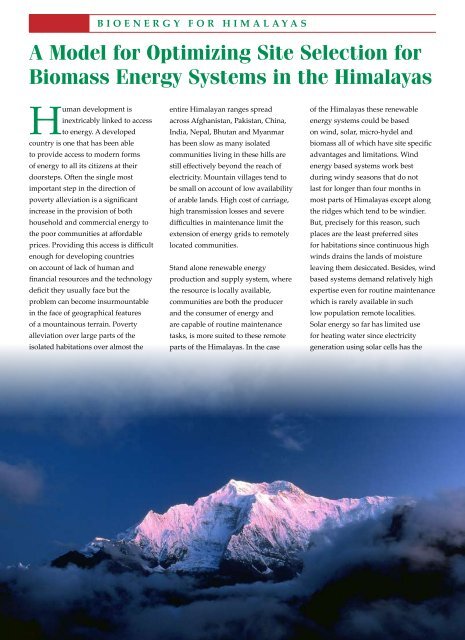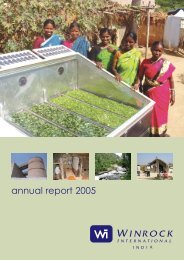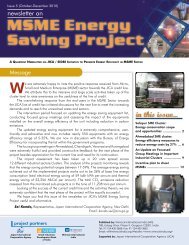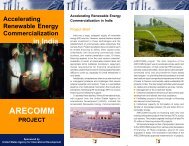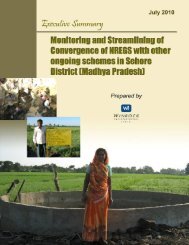IssuE 8 â ApRIl â JuNE 2011 - Winrock International India
IssuE 8 â ApRIl â JuNE 2011 - Winrock International India
IssuE 8 â ApRIl â JuNE 2011 - Winrock International India
Create successful ePaper yourself
Turn your PDF publications into a flip-book with our unique Google optimized e-Paper software.
Bioenergy for Himalayas<br />
A Model for Optimizing Site Selection for<br />
Biomass Energy Systems in the Himalayas<br />
Human development is<br />
inextricably linked to access<br />
to energy. A developed<br />
country is one that has been able<br />
to provide access to modern forms<br />
of energy to all its citizens at their<br />
doorsteps. Often the single most<br />
important step in the direction of<br />
poverty alleviation is a significant<br />
increase in the provision of both<br />
household and commercial energy to<br />
the poor communities at affordable<br />
prices. Providing this access is difficult<br />
enough for developing countries<br />
on account of lack of human and<br />
financial resources and the technology<br />
deficit they usually face but the<br />
problem can become insurmountable<br />
in the face of geographical features<br />
of a mountainous terrain. Poverty<br />
alleviation over large parts of the<br />
isolated habitations over almost the<br />
entire Himalayan ranges spread<br />
across Afghanistan, Pakistan, China,<br />
<strong>India</strong>, Nepal, Bhutan and Myanmar<br />
has been slow as many isolated<br />
communities living in these hills are<br />
still effectively beyond the reach of<br />
electricity. Mountain villages tend to<br />
be small on account of low availability<br />
of arable lands. High cost of carriage,<br />
high transmission losses and severe<br />
difficulties in maintenance limit the<br />
extension of energy grids to remotely<br />
located communities.<br />
Stand alone renewable energy<br />
production and supply system, where<br />
the resource is locally available,<br />
communities are both the producer<br />
and the consumer of energy and<br />
are capable of routine maintenance<br />
tasks, is more suited to these remote<br />
parts of the Himalayas. In the case<br />
of the Himalayas these renewable<br />
energy systems could be based<br />
on wind, solar, micro-hydel and<br />
biomass all of which have site specific<br />
advantages and limitations. Wind<br />
energy based systems work best<br />
during windy seasons that do not<br />
last for longer than four months in<br />
most parts of Himalayas except along<br />
the ridges which tend to be windier.<br />
But, precisely for this reason, such<br />
places are the least preferred sites<br />
for habitations since continuous high<br />
winds drains the lands of moisture<br />
leaving them desiccated. Besides, wind<br />
based systems demand relatively high<br />
expertise even for routine maintenance<br />
which is rarely available in such<br />
low population remote localities.<br />
Solar energy so far has limited use<br />
for heating water since electricity<br />
generation using solar cells has the<br />
14 April-June <strong>2011</strong>


